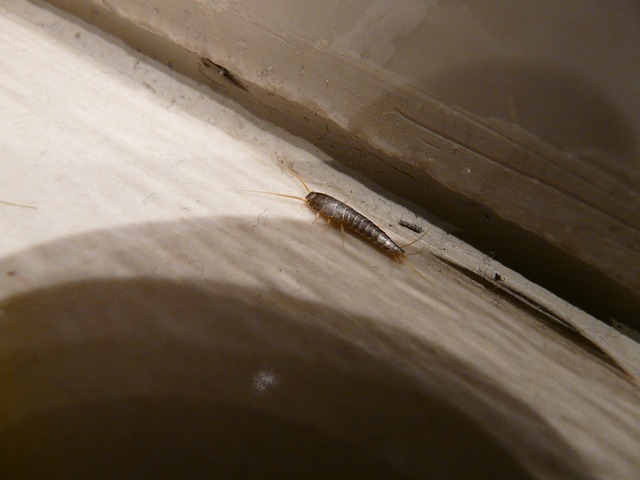Silverfish, nocturnal and elusive pests, thrive in dark, humid environments. Residential treatments involve sealing entry points, improving ventilation, using insecticides and bait stations, while commercial settings employ integrated pest management (IPM) with regular inspections, sanitization, and less harmful pesticides. Recognizing signs like live/dead silverfish, damaged paper products, discarded exoskeletons, and a musty odor is crucial for effective control. Prompt action on these indicators is key for both residential and commercial residential silverfish treatment. Professional pest control offers tailored solutions, utilizing natural deterrents, targeted treatments, and preventive measures to achieve lasting results. Regular inspections and maintenance contracts are recommended for ongoing protection in commercial spaces.
Silverfish, those pesky critters, can quickly transform from minor inconveniences to major infestations in both residential and commercial spaces. This article provides tailored strategies for effective silverfish control, focusing on both home and business environments. By understanding silverfish behavior and identifying subtle signs of infestation, we offer comprehensive approaches for residential treatment and professional techniques for managing large-scale commercial outbreaks. Discover how to reclaim your spaces from these persistent invaders.
Understanding Silverfish: Behavior and Habitat in Residential and Commercial Settings
Silverfish are elusive, nocturnal insects that can quickly multiply and become a persistent pest in both residential and commercial spaces. Understanding their behavior is crucial for effective silverfish control. In homes, they tend to hide in dark, humid areas such as basements, crawl spaces, and behind appliances, where they feed on starchy materials like paper products, cardboard, and fabric. Commercial buildings often face similar challenges, with silverfish attracted to areas with high moisture levels, including kitchens, bathrooms, and storage rooms. Their ability to move through tiny crevices makes them hard to eradicate once established.
Residential silverfish treatment typically involves a combination of non-chemical and chemical interventions. Sealing entry points, improving ventilation, and reducing humidity can deter their presence. Chemical treatments may include targeted insecticides, bait stations, or residual sprays applied by professionals. In commercial settings, integrated pest management (IPM) strategies are often employed, focusing on regular inspections, sanitization, and the use of less harmful pesticides to maintain a silverfish-free environment.
Identifying Signs of Silverfish Infestation in Homes and Businesses
Recognizing the signs of a silverfish infestation is crucial for effective residential and commercial silverfish control. One of the most common indicators is the presence of live or dead silverfish, which can be easily spotted in corners, behind appliances, and under furniture. While they prefer moist environments, their adaptability allows them to thrive in both humid and dry spaces.
Beyond visual sightings, keep an eye out for telltale signs such as damaged paper products, cardboard, or fabric. Silverfish leave tiny holes in these materials, especially along seams and creases. Moreover, look for discarded exoskeletons, which resemble small, light-colored insects cast off as silverfish molt. In homes and businesses alike, a persistent musty odor may also signal an infestation, as silverfish are attracted to and feed on starchy items, resulting in a distinct scent.
Effective Residential Silverfish Treatment Methods: A Comprehensive Approach
Silverfish are relentless invaders that can quickly infest both residential and commercial properties. For effective residential silverfish treatment, a comprehensive approach is essential. This involves identifying and addressing the source of the infestation, as these insects thrive in dark, damp areas such as basements, bathrooms, and kitchens. Regular inspections should be conducted to pinpoint their hiding places and track their movements.
Professional pest control services offer tailored solutions that combine targeted treatments with preventive measures. This may include applying insecticides in crevices, sealing entry points, and implementing a regular maintenance schedule. Additionally, homeowners can employ natural deterrents like cedar oil or diatomaceous earth to create an environment less appealing to silverfish. A multifaceted strategy is key to achieving lasting results in residential silverfish treatment.
Professional Commercial Silverfish Control: Strategies for Large-Scale Infestations
In cases of large-scale or commercial silverfish infestations, a professional approach is often necessary. Commercial spaces like offices, warehouses, and retail stores present unique challenges due to their size and complexity. Professional pest control services offer tailored strategies that go beyond standard residential treatments. They employ advanced techniques such as thermal remediation, which uses heat to eliminate silverfish in hard-to-reach areas, and targeted chemical applications designed to disrupt silverfish life cycles without harming residents or inventory.
Additionally, professionals utilize monitoring systems to track infestation progress and adjust their methods accordingly. This data-driven approach ensures that every nook and cranny is treated effectively, preventing future reinfestations. For large-scale operations, regular maintenance contracts are often recommended, providing continuous protection against silverfish and other pests. Such comprehensive strategies are crucial for maintaining a clean, safe, and efficient working environment, addressing the specific needs of commercial settings through residential silverfish treatment methods elevated to meet industry standards.
In addressing the challenges posed by silverfish infestations in both residential and commercial spaces, it’s clear that a tailored approach is key. By understanding these insects’ behaviors and habitats, we can effectively identify signs of an infestation early on. For homes, a comprehensive strategy involving sanitization, sealing entry points, and targeted treatments offers robust protection. In commercial settings, professional intervention with specialized equipment and eco-friendly methods ensures large-scale infestations are swiftly and safely managed. Implementing these tailored strategies for residential silverfish treatment can help maintain pest-free environments, safeguarding both homes and businesses from these persistent intruders.
